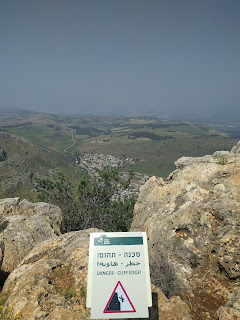Mount Arbel
I'm not much of a hiker but I would have walked the trail this time had it not been for my sprained ankle (that I am still pampering!). The hike through Har Arbel, the Arbel mountain is worthwhile and appropriate for every age. As with most places in Israel even hiking trails have a wheelchair accessible path. Fortunately there's a little kiosk at the entrance where "tembelim" (fools) like me can purchase the hat they forgot to bring. I purchased a lovely "kova tembel" (fools hat) that was perfect for the hike!
I managed to walk at least to a few choice lookout points which were simply breathtaking - - and I nearly lost my breath just taking a peek over the cliffs!
Upon your return when you're all hot and sweaty you will find water faucets for refills, washing up and even for cleaning your feet.
Israel is wonderful about preserving the land and nature. This spot is one example of how much Israeli's love this land. Click on this link to learn more about the Arbel Nature Reserve (they also have some fabulous photos).
The history of the Arbel region is fascinating. Here is a tidbit from Wikipedia (click on this link to learn more):
Nearby are the ruins of an ancient Jewish settlement with a synagogue from the fourth century CE with pews and columns.
Dug into the mountain itself are a number of cave dwellings, expanded from natural caves. There are documented Jewish cliff dwellings dating back to the Second Temple period in the area. The extant fortification walls protecting some of these caves are from the 17th century and were built by Ali Bek, son of the Druze emir Fakhr ad-Din al-Ma'ani. Josephus writes about how Herod the Great, with the help of Roman soldiers, defeated some of the last rebels who supported the Hasmonean king Antigonus and had taken refuge in the cliffs of Mt Arbel.
It is also Josephus who, writing about himself in the third person, tells us about his deeds at the beginning of the First Jewish–Roman War in the year 66 CE:"Moreover, he [Josephus] built walls about the caves near the lake of Gennesar, which places lay in the lower Galilee".
The caves on the steep northern side were reused in the Ottoman period by the Druze Ma'ani dynasty to create the cave castleknown as Qal'at Ibn Ma'an.
Sadly I was not able to visit the fortress, caves (my family noted that cows were there in the caves!!!) and the remains of the ancient temple but I enjoyed the bit of hike that I did - especially the beautiful views, the flowers peeping out from the crevices in the rocks, the butterflies flitting around them, and even a little bird in the pathway.
I managed to walk at least to a few choice lookout points which were simply breathtaking - - and I nearly lost my breath just taking a peek over the cliffs!
Upon your return when you're all hot and sweaty you will find water faucets for refills, washing up and even for cleaning your feet.
Israel is wonderful about preserving the land and nature. This spot is one example of how much Israeli's love this land. Click on this link to learn more about the Arbel Nature Reserve (they also have some fabulous photos).
The history of the Arbel region is fascinating. Here is a tidbit from Wikipedia (click on this link to learn more):
Nearby are the ruins of an ancient Jewish settlement with a synagogue from the fourth century CE with pews and columns.
Dug into the mountain itself are a number of cave dwellings, expanded from natural caves. There are documented Jewish cliff dwellings dating back to the Second Temple period in the area. The extant fortification walls protecting some of these caves are from the 17th century and were built by Ali Bek, son of the Druze emir Fakhr ad-Din al-Ma'ani. Josephus writes about how Herod the Great, with the help of Roman soldiers, defeated some of the last rebels who supported the Hasmonean king Antigonus and had taken refuge in the cliffs of Mt Arbel.
It is also Josephus who, writing about himself in the third person, tells us about his deeds at the beginning of the First Jewish–Roman War in the year 66 CE:"Moreover, he [Josephus] built walls about the caves near the lake of Gennesar, which places lay in the lower Galilee".
The caves on the steep northern side were reused in the Ottoman period by the Druze Ma'ani dynasty to create the cave castleknown as Qal'at Ibn Ma'an.
Finally, as I waited for my family to return from the extended hike, I had a chance to read more about the site. It intrigued me to learn that Romans rigged up a contraption with which they were able to overcome the warriors and finally conquer the area. They built a cage-like structure on which their soldiers stood armed with bows and flaming arrows, the weaponry of the time. The structure was then lowered slowly to the cave entrances. The Romans shot their bows and flaming arrows into the caves and at the warriors who ended up being trapped thus losing the battles.










































Comments
Post a Comment